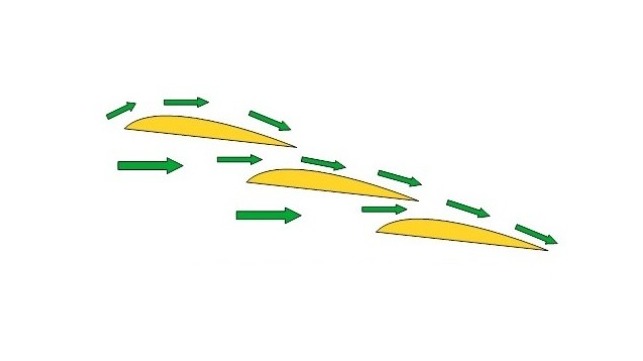A Multi-Slat Hydrofoil for Low-Speed Sailing in Heavy Seas

Aeronautical hobbyists have built, tested and flown scale model airplanes that use multi-slat aeronautical main wings that provide higher lift at lower speed than conventional main wings. The aeronautical concept provides a basis by which to develop multi-slat hydrofoils capable of sailing passenger vessels at low speed through heavy seas with greatly reduced vessel pitching and rolling motions. Vessels using such technology could be assigned to short-distance ferry service or multi-stop regional coastal service.
Introduction
There is much overlap or duplication between aeronautical wing technology and marine hydrofoils, with the latter providing the equivalent of flight when sailing at a certain speed through water and lifting a boat hull upward. Traditional hydrofoils are an old concept that have typically activated at elevated speeds, but were rarely applied to the boat industry. In more recent years, the wind-powered competition boat fraternity applied hydrofoil technology to increase the sailing speed of racing yachts and with spectacular results. Surfboard enthusiasts subsequently adapted small hydrofoils for installation under surfboards to increase speed.
Hydrofoils have been applied to oar-powered racing kayaks and human pedal-powered water craft to reduce drag and increase speed while providing smoother ride when sailing through choppy water. While a segment of the maritime sector focuses on developing hydrofoils to achieve higher sailing speeds, there are potential market niches for slow sailing vessels that will be required to provide smooth ride over short distances, such as a ferry required to sail through severely choppy water or a coastal boat that makes multiple calls at small ports. A recent aeronautical innovation with possible maritime application may achieve such a purpose.
The Multi-Slat Wing
While many aircraft use slats attached to wings to increase the lift phenomena at low speed, some enthusiasts have taken the concept to an extreme by building scale model aircraft that use a series of slats for wings, with one concept even resembling a staircase. In flight, the same wind stream that flows under a leading slat subsequently flows over a trailing slat and including when flown in fixed-wing mode. Such operation provides a precedent to develop a multiple-slat fixed-wing hydrofoil that is free from moving components and capable of providing upward lift at low sailing speed.
While the hydrofoil-catamaran battery powered Sea-Bubble water taxi lifts its hull above water at nine knots, there may be scope to develop a multi-slat fixed-wing hydrofoil that would lift a vessel hull above water perhaps as low at six knots, or equal to the highest recorded sailing speed of a wave-powered vessel. Windmill-powered vessels have sailing directly into headwinds at speeds as high as eight knots. Fixed-wing technology installed below the water line translates to greater long-term reliability and allowing a vessel to remain in continuous service over extended durations of time and distance.
Rough Seas
Rough seas and severely choppy seawater occur frequently in regions where slow-sailing vessels provide ferry services or provide services to coastal communities that are difficult to access via road or railway. Installation of multi-slat hydrofoils offers the possibility of providing smoother ride characteristics with greatly reduced roll, pitching and vertical heave motions when a small vessel sails at low speed through rough sea conditions. The proof-of-concept precedent involving operation of working scale-model aircraft that have flown using multi-slat wings provides the basis for a multi-slat hydrofoil to lift a boat hull above water at lower speed.
A fixed-wing multi-slat hydrofoil eliminates moving or hinged components that rough sea conditions could damage, thereby increasing the durability and longevity of such technology. Previous research and development into hydrofoils suggests that catamaran vessels equipped with hydrofoils represent the optimal configuration, especially with hydrofoils set with the outer edges installed at higher elevation than the inner edges to produce a high roll-axis. The worst of local sea conditions at any geographic location where ferry or local coastal boats operate would determine the elevation to which hydrofoils would raise the hull above water.
Future Research
Boat designers, engineers and marine architects would need to evaluate the multi-slat wing concept for potential maritime hydrofoil application. The success in the aeronautical sector suggests potential for successful adaptation for installation under twin-hull catamaran design of vessels. Maritime researchers and designers would likely make changes and modifications to the multi-slat concept as it is adapted to maritime application. A fixed-wing multi-slat hydrofoil concept represents an optimal configuration with potential to offer enhanced performance to future windmill-powered and wave-powered vessels that sail extended distances across ocean and including through rough sea conditions.
Conclusions
A hydrofoil version of the multi-slat aeronautical wing has potential application on smaller vessels that are required to sail for comparatively short distances through rough sea conditions. It would have further application of wind and wave powered vessels, including when sailing extended distances across ocean and especially when encountering storms at sea or severe wind-driven wave conditions.
The opinions expressed herein are the author's and not necessarily those of The Maritime Executive.

